Strategic Planning for Tourism and Leisure: A Report [TLH302]
VerifiedAdded on 2021/05/31
|19
|5468
|150
Report
AI Summary
This report delves into the realm of strategic planning within the tourism and leisure sector, emphasizing its critical role in economic development and destination management. The study commences with a comprehensive definition of strategic planning, followed by an examination of its characteristics, particularly within the context of tourism. The report then highlights the significance of tourism as a major economic contributor and the necessity for robust strategic planning to maximize its potential. A coastal area, Clacton-on-Sea, serves as a principal case study, with the report analyzing its current social, economic, and health challenges. The study explores the advantages of strategic planning in tourism, offering insights into how it can address issues like unemployment, boost local economies, and improve infrastructure. The report also discusses different planning approaches, such as boosterism, and evaluates their pros and cons. Ultimately, the report underscores the importance of sustainable tourism planning and the need for stakeholder involvement to ensure long-term benefits for both tourists and host communities. The report is a valuable resource for students, offering insights into strategic planning in the tourism sector, using a real-world case study to illustrate the concepts.
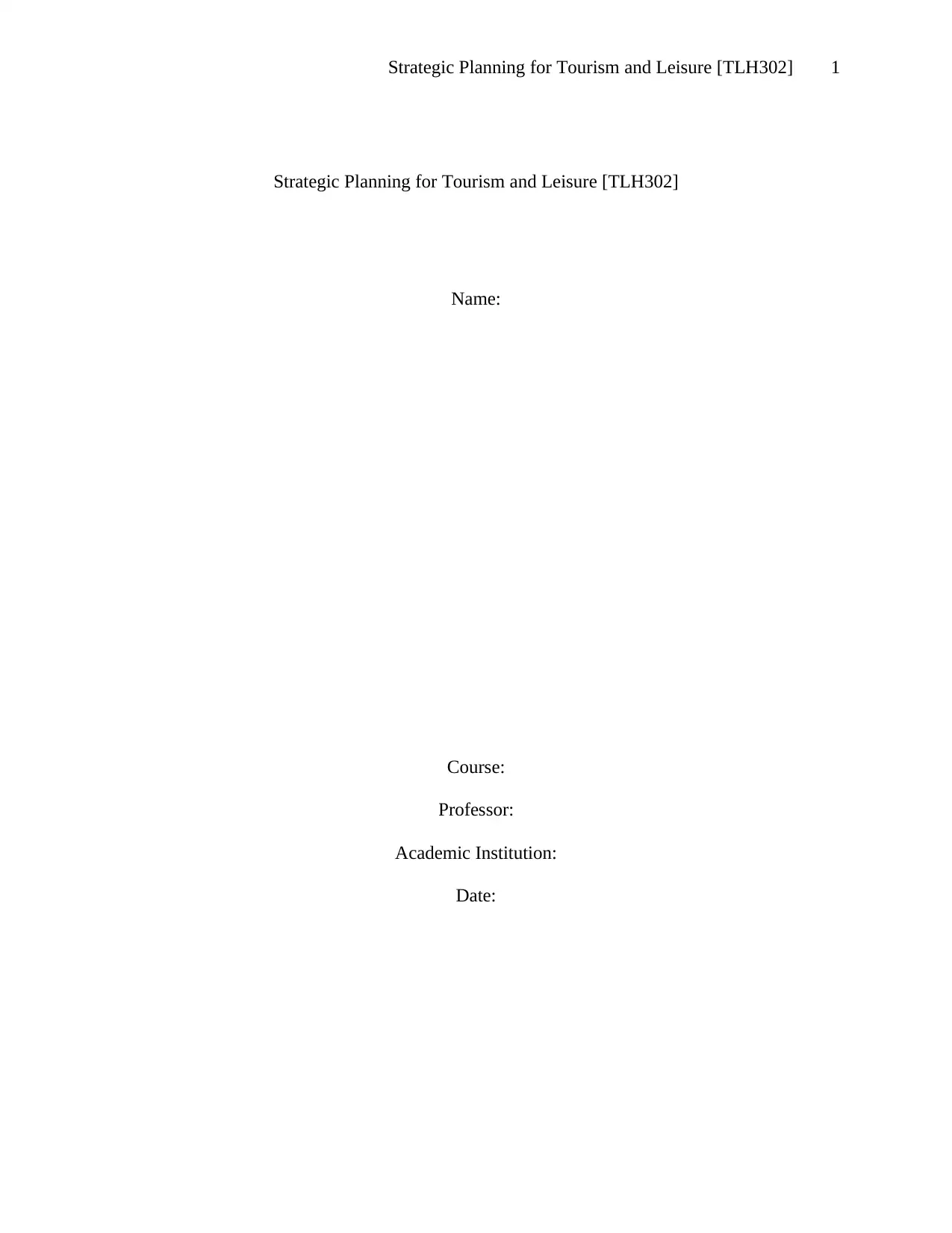
Strategic Planning for Tourism and Leisure [TLH302] 1
Strategic Planning for Tourism and Leisure [TLH302]
Name:
Course:
Professor:
Academic Institution:
Date:
Strategic Planning for Tourism and Leisure [TLH302]
Name:
Course:
Professor:
Academic Institution:
Date:
Paraphrase This Document
Need a fresh take? Get an instant paraphrase of this document with our AI Paraphraser
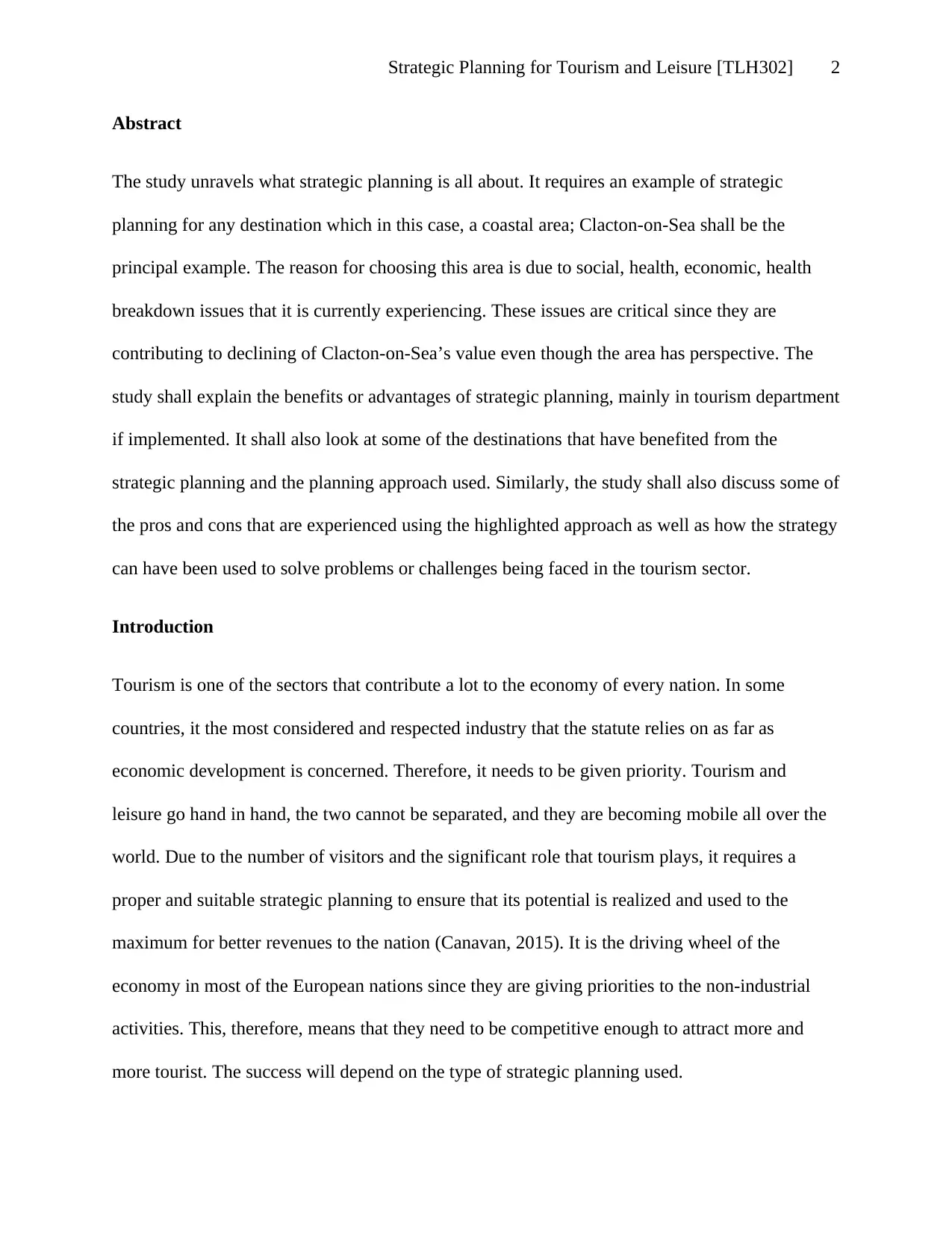
Strategic Planning for Tourism and Leisure [TLH302] 2
Abstract
The study unravels what strategic planning is all about. It requires an example of strategic
planning for any destination which in this case, a coastal area; Clacton-on-Sea shall be the
principal example. The reason for choosing this area is due to social, health, economic, health
breakdown issues that it is currently experiencing. These issues are critical since they are
contributing to declining of Clacton-on-Sea’s value even though the area has perspective. The
study shall explain the benefits or advantages of strategic planning, mainly in tourism department
if implemented. It shall also look at some of the destinations that have benefited from the
strategic planning and the planning approach used. Similarly, the study shall also discuss some of
the pros and cons that are experienced using the highlighted approach as well as how the strategy
can have been used to solve problems or challenges being faced in the tourism sector.
Introduction
Tourism is one of the sectors that contribute a lot to the economy of every nation. In some
countries, it the most considered and respected industry that the statute relies on as far as
economic development is concerned. Therefore, it needs to be given priority. Tourism and
leisure go hand in hand, the two cannot be separated, and they are becoming mobile all over the
world. Due to the number of visitors and the significant role that tourism plays, it requires a
proper and suitable strategic planning to ensure that its potential is realized and used to the
maximum for better revenues to the nation (Canavan, 2015). It is the driving wheel of the
economy in most of the European nations since they are giving priorities to the non-industrial
activities. This, therefore, means that they need to be competitive enough to attract more and
more tourist. The success will depend on the type of strategic planning used.
Abstract
The study unravels what strategic planning is all about. It requires an example of strategic
planning for any destination which in this case, a coastal area; Clacton-on-Sea shall be the
principal example. The reason for choosing this area is due to social, health, economic, health
breakdown issues that it is currently experiencing. These issues are critical since they are
contributing to declining of Clacton-on-Sea’s value even though the area has perspective. The
study shall explain the benefits or advantages of strategic planning, mainly in tourism department
if implemented. It shall also look at some of the destinations that have benefited from the
strategic planning and the planning approach used. Similarly, the study shall also discuss some of
the pros and cons that are experienced using the highlighted approach as well as how the strategy
can have been used to solve problems or challenges being faced in the tourism sector.
Introduction
Tourism is one of the sectors that contribute a lot to the economy of every nation. In some
countries, it the most considered and respected industry that the statute relies on as far as
economic development is concerned. Therefore, it needs to be given priority. Tourism and
leisure go hand in hand, the two cannot be separated, and they are becoming mobile all over the
world. Due to the number of visitors and the significant role that tourism plays, it requires a
proper and suitable strategic planning to ensure that its potential is realized and used to the
maximum for better revenues to the nation (Canavan, 2015). It is the driving wheel of the
economy in most of the European nations since they are giving priorities to the non-industrial
activities. This, therefore, means that they need to be competitive enough to attract more and
more tourist. The success will depend on the type of strategic planning used.
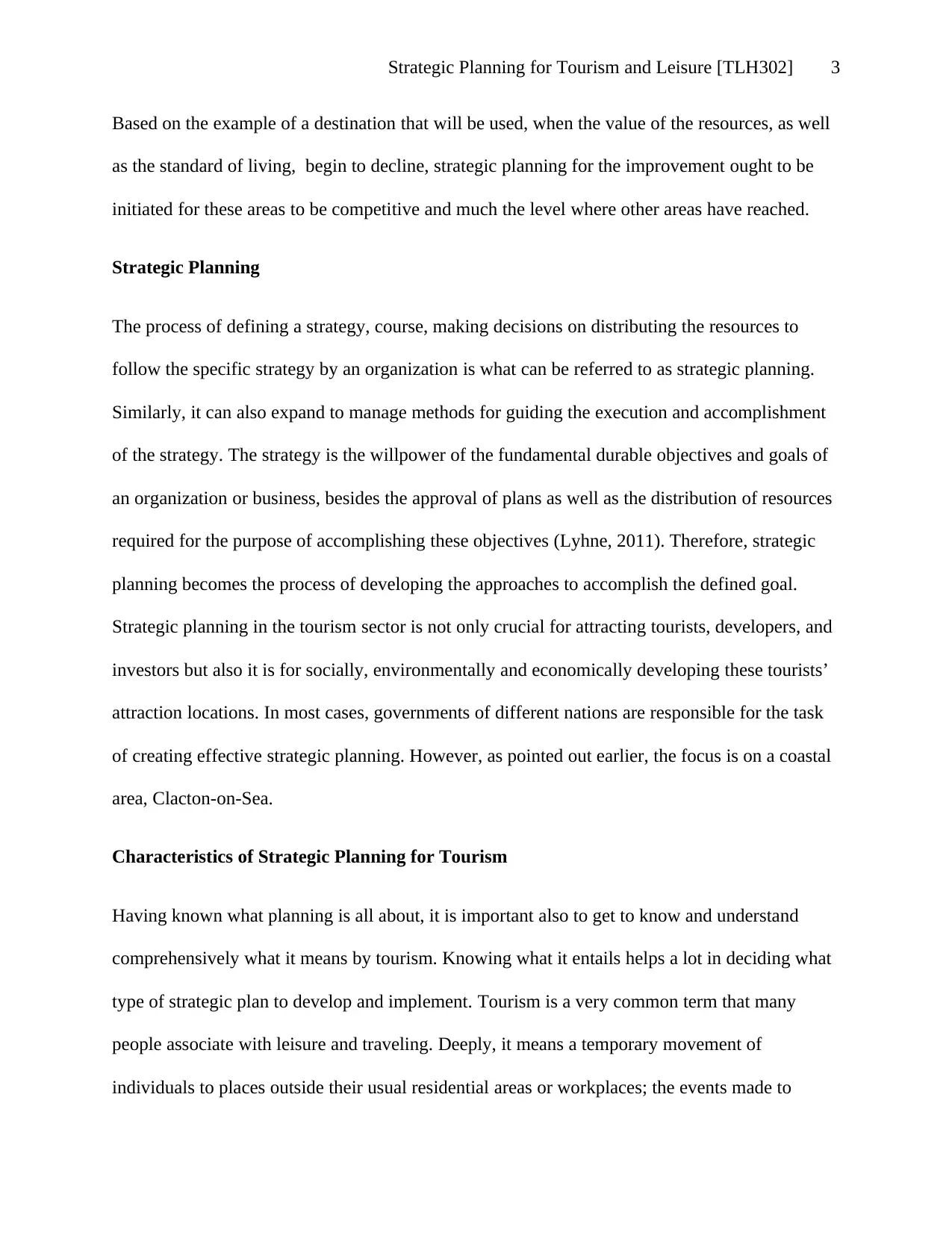
Strategic Planning for Tourism and Leisure [TLH302] 3
Based on the example of a destination that will be used, when the value of the resources, as well
as the standard of living, begin to decline, strategic planning for the improvement ought to be
initiated for these areas to be competitive and much the level where other areas have reached.
Strategic Planning
The process of defining a strategy, course, making decisions on distributing the resources to
follow the specific strategy by an organization is what can be referred to as strategic planning.
Similarly, it can also expand to manage methods for guiding the execution and accomplishment
of the strategy. The strategy is the willpower of the fundamental durable objectives and goals of
an organization or business, besides the approval of plans as well as the distribution of resources
required for the purpose of accomplishing these objectives (Lyhne, 2011). Therefore, strategic
planning becomes the process of developing the approaches to accomplish the defined goal.
Strategic planning in the tourism sector is not only crucial for attracting tourists, developers, and
investors but also it is for socially, environmentally and economically developing these tourists’
attraction locations. In most cases, governments of different nations are responsible for the task
of creating effective strategic planning. However, as pointed out earlier, the focus is on a coastal
area, Clacton-on-Sea.
Characteristics of Strategic Planning for Tourism
Having known what planning is all about, it is important also to get to know and understand
comprehensively what it means by tourism. Knowing what it entails helps a lot in deciding what
type of strategic plan to develop and implement. Tourism is a very common term that many
people associate with leisure and traveling. Deeply, it means a temporary movement of
individuals to places outside their usual residential areas or workplaces; the events made to
Based on the example of a destination that will be used, when the value of the resources, as well
as the standard of living, begin to decline, strategic planning for the improvement ought to be
initiated for these areas to be competitive and much the level where other areas have reached.
Strategic Planning
The process of defining a strategy, course, making decisions on distributing the resources to
follow the specific strategy by an organization is what can be referred to as strategic planning.
Similarly, it can also expand to manage methods for guiding the execution and accomplishment
of the strategy. The strategy is the willpower of the fundamental durable objectives and goals of
an organization or business, besides the approval of plans as well as the distribution of resources
required for the purpose of accomplishing these objectives (Lyhne, 2011). Therefore, strategic
planning becomes the process of developing the approaches to accomplish the defined goal.
Strategic planning in the tourism sector is not only crucial for attracting tourists, developers, and
investors but also it is for socially, environmentally and economically developing these tourists’
attraction locations. In most cases, governments of different nations are responsible for the task
of creating effective strategic planning. However, as pointed out earlier, the focus is on a coastal
area, Clacton-on-Sea.
Characteristics of Strategic Planning for Tourism
Having known what planning is all about, it is important also to get to know and understand
comprehensively what it means by tourism. Knowing what it entails helps a lot in deciding what
type of strategic plan to develop and implement. Tourism is a very common term that many
people associate with leisure and traveling. Deeply, it means a temporary movement of
individuals to places outside their usual residential areas or workplaces; the events made to
⊘ This is a preview!⊘
Do you want full access?
Subscribe today to unlock all pages.

Trusted by 1+ million students worldwide
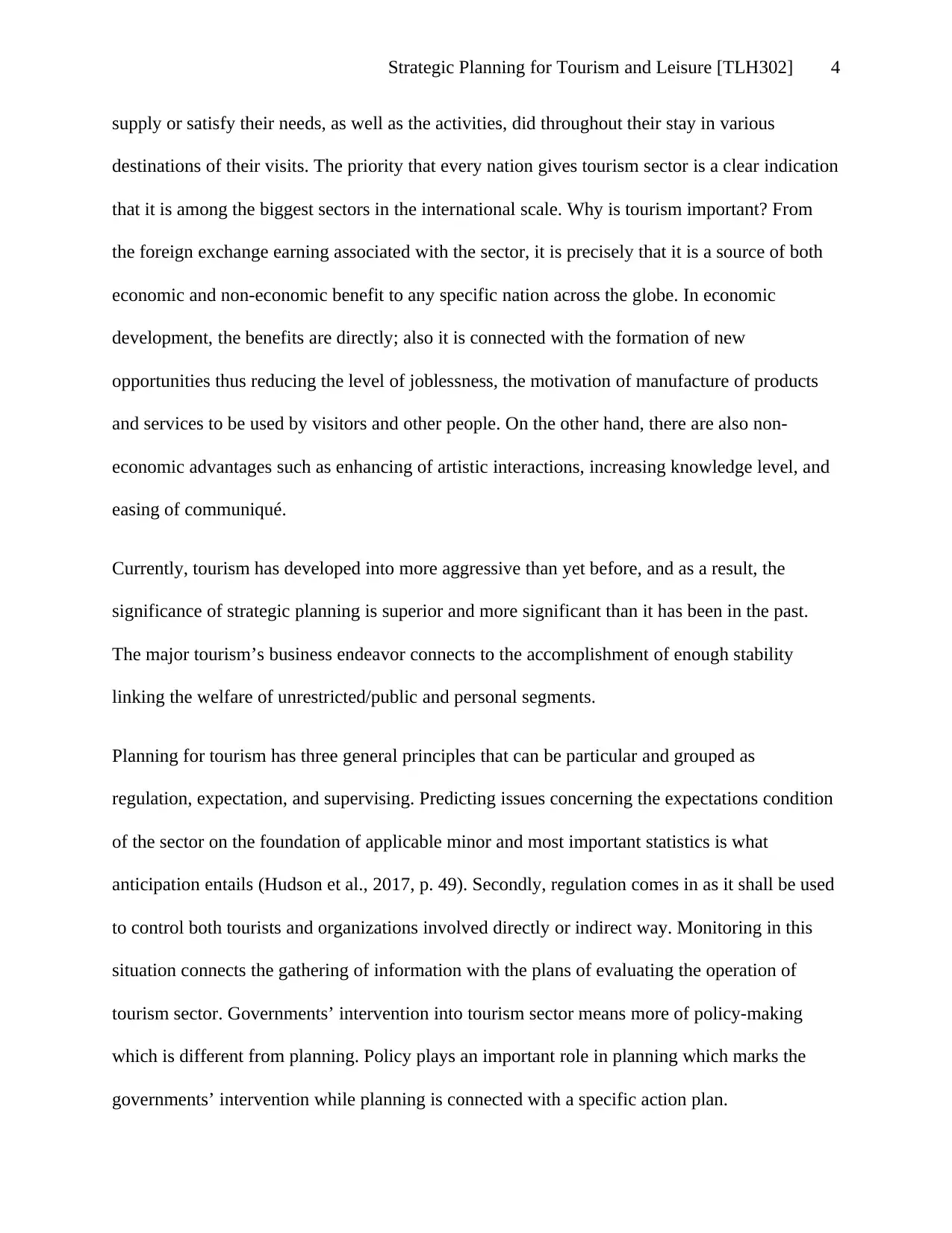
Strategic Planning for Tourism and Leisure [TLH302] 4
supply or satisfy their needs, as well as the activities, did throughout their stay in various
destinations of their visits. The priority that every nation gives tourism sector is a clear indication
that it is among the biggest sectors in the international scale. Why is tourism important? From
the foreign exchange earning associated with the sector, it is precisely that it is a source of both
economic and non-economic benefit to any specific nation across the globe. In economic
development, the benefits are directly; also it is connected with the formation of new
opportunities thus reducing the level of joblessness, the motivation of manufacture of products
and services to be used by visitors and other people. On the other hand, there are also non-
economic advantages such as enhancing of artistic interactions, increasing knowledge level, and
easing of communiqué.
Currently, tourism has developed into more aggressive than yet before, and as a result, the
significance of strategic planning is superior and more significant than it has been in the past.
The major tourism’s business endeavor connects to the accomplishment of enough stability
linking the welfare of unrestricted/public and personal segments.
Planning for tourism has three general principles that can be particular and grouped as
regulation, expectation, and supervising. Predicting issues concerning the expectations condition
of the sector on the foundation of applicable minor and most important statistics is what
anticipation entails (Hudson et al., 2017, p. 49). Secondly, regulation comes in as it shall be used
to control both tourists and organizations involved directly or indirect way. Monitoring in this
situation connects the gathering of information with the plans of evaluating the operation of
tourism sector. Governments’ intervention into tourism sector means more of policy-making
which is different from planning. Policy plays an important role in planning which marks the
governments’ intervention while planning is connected with a specific action plan.
supply or satisfy their needs, as well as the activities, did throughout their stay in various
destinations of their visits. The priority that every nation gives tourism sector is a clear indication
that it is among the biggest sectors in the international scale. Why is tourism important? From
the foreign exchange earning associated with the sector, it is precisely that it is a source of both
economic and non-economic benefit to any specific nation across the globe. In economic
development, the benefits are directly; also it is connected with the formation of new
opportunities thus reducing the level of joblessness, the motivation of manufacture of products
and services to be used by visitors and other people. On the other hand, there are also non-
economic advantages such as enhancing of artistic interactions, increasing knowledge level, and
easing of communiqué.
Currently, tourism has developed into more aggressive than yet before, and as a result, the
significance of strategic planning is superior and more significant than it has been in the past.
The major tourism’s business endeavor connects to the accomplishment of enough stability
linking the welfare of unrestricted/public and personal segments.
Planning for tourism has three general principles that can be particular and grouped as
regulation, expectation, and supervising. Predicting issues concerning the expectations condition
of the sector on the foundation of applicable minor and most important statistics is what
anticipation entails (Hudson et al., 2017, p. 49). Secondly, regulation comes in as it shall be used
to control both tourists and organizations involved directly or indirect way. Monitoring in this
situation connects the gathering of information with the plans of evaluating the operation of
tourism sector. Governments’ intervention into tourism sector means more of policy-making
which is different from planning. Policy plays an important role in planning which marks the
governments’ intervention while planning is connected with a specific action plan.
Paraphrase This Document
Need a fresh take? Get an instant paraphrase of this document with our AI Paraphraser
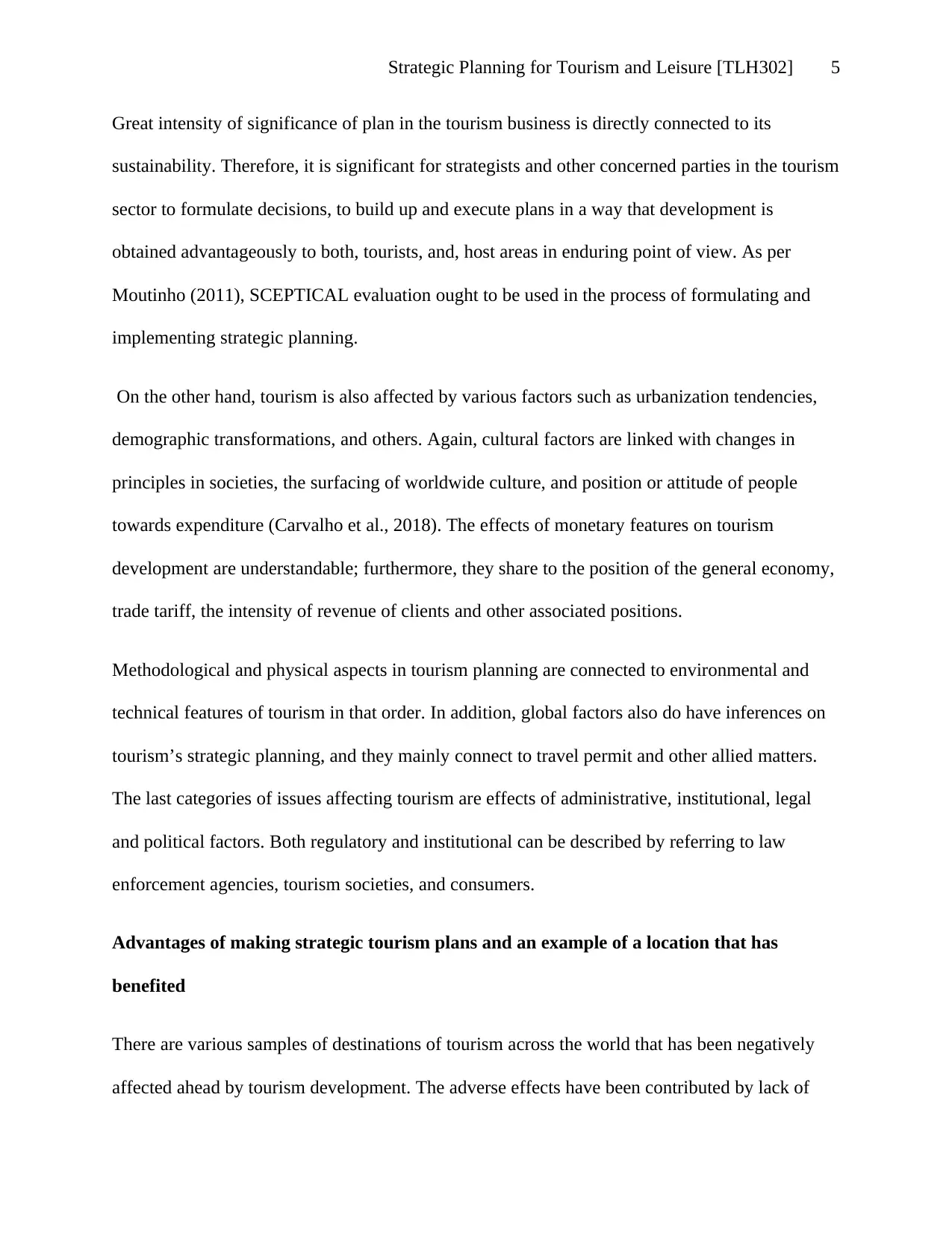
Strategic Planning for Tourism and Leisure [TLH302] 5
Great intensity of significance of plan in the tourism business is directly connected to its
sustainability. Therefore, it is significant for strategists and other concerned parties in the tourism
sector to formulate decisions, to build up and execute plans in a way that development is
obtained advantageously to both, tourists, and, host areas in enduring point of view. As per
Moutinho (2011), SCEPTICAL evaluation ought to be used in the process of formulating and
implementing strategic planning.
On the other hand, tourism is also affected by various factors such as urbanization tendencies,
demographic transformations, and others. Again, cultural factors are linked with changes in
principles in societies, the surfacing of worldwide culture, and position or attitude of people
towards expenditure (Carvalho et al., 2018). The effects of monetary features on tourism
development are understandable; furthermore, they share to the position of the general economy,
trade tariff, the intensity of revenue of clients and other associated positions.
Methodological and physical aspects in tourism planning are connected to environmental and
technical features of tourism in that order. In addition, global factors also do have inferences on
tourism’s strategic planning, and they mainly connect to travel permit and other allied matters.
The last categories of issues affecting tourism are effects of administrative, institutional, legal
and political factors. Both regulatory and institutional can be described by referring to law
enforcement agencies, tourism societies, and consumers.
Advantages of making strategic tourism plans and an example of a location that has
benefited
There are various samples of destinations of tourism across the world that has been negatively
affected ahead by tourism development. The adverse effects have been contributed by lack of
Great intensity of significance of plan in the tourism business is directly connected to its
sustainability. Therefore, it is significant for strategists and other concerned parties in the tourism
sector to formulate decisions, to build up and execute plans in a way that development is
obtained advantageously to both, tourists, and, host areas in enduring point of view. As per
Moutinho (2011), SCEPTICAL evaluation ought to be used in the process of formulating and
implementing strategic planning.
On the other hand, tourism is also affected by various factors such as urbanization tendencies,
demographic transformations, and others. Again, cultural factors are linked with changes in
principles in societies, the surfacing of worldwide culture, and position or attitude of people
towards expenditure (Carvalho et al., 2018). The effects of monetary features on tourism
development are understandable; furthermore, they share to the position of the general economy,
trade tariff, the intensity of revenue of clients and other associated positions.
Methodological and physical aspects in tourism planning are connected to environmental and
technical features of tourism in that order. In addition, global factors also do have inferences on
tourism’s strategic planning, and they mainly connect to travel permit and other allied matters.
The last categories of issues affecting tourism are effects of administrative, institutional, legal
and political factors. Both regulatory and institutional can be described by referring to law
enforcement agencies, tourism societies, and consumers.
Advantages of making strategic tourism plans and an example of a location that has
benefited
There are various samples of destinations of tourism across the world that has been negatively
affected ahead by tourism development. The adverse effects have been contributed by lack of
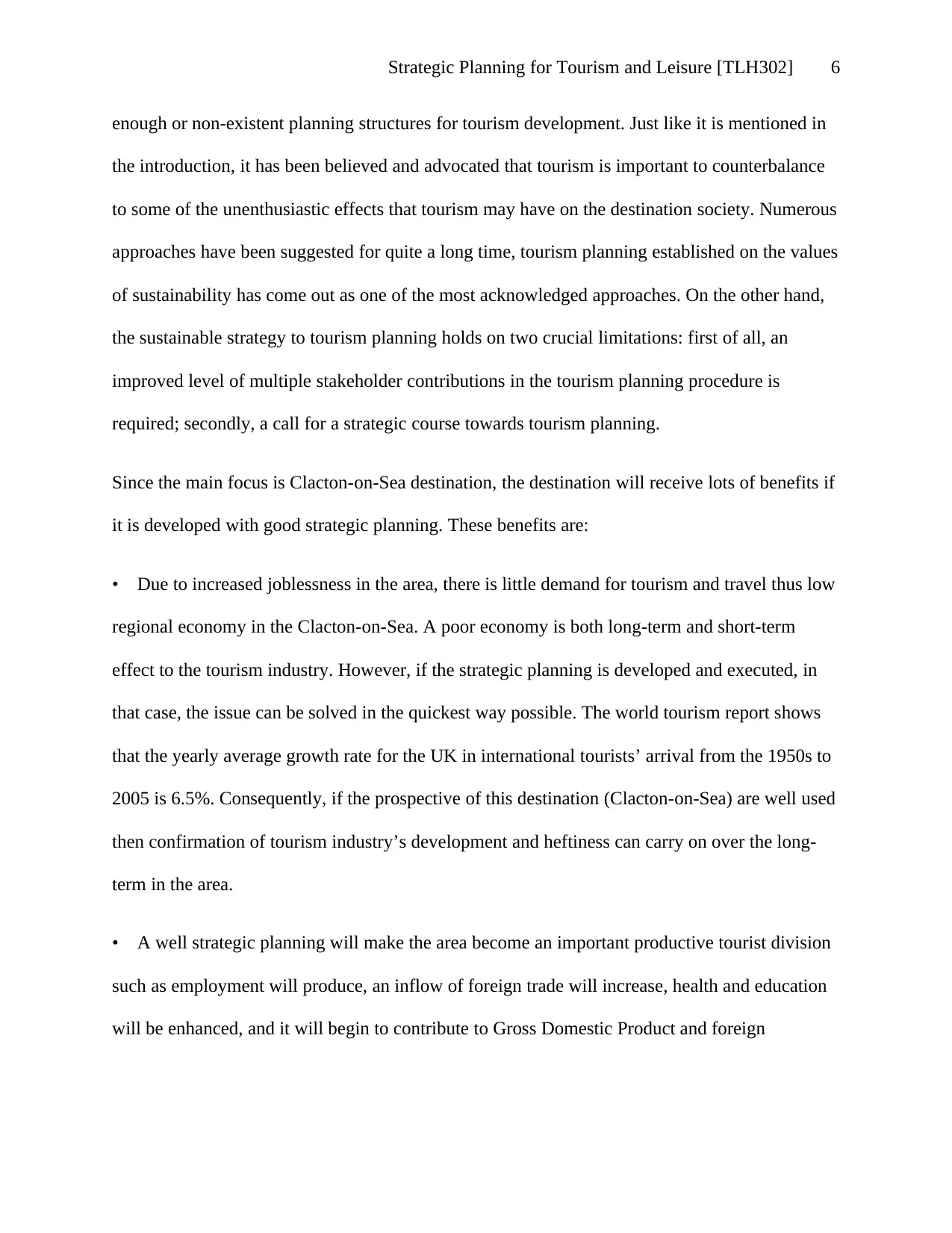
Strategic Planning for Tourism and Leisure [TLH302] 6
enough or non-existent planning structures for tourism development. Just like it is mentioned in
the introduction, it has been believed and advocated that tourism is important to counterbalance
to some of the unenthusiastic effects that tourism may have on the destination society. Numerous
approaches have been suggested for quite a long time, tourism planning established on the values
of sustainability has come out as one of the most acknowledged approaches. On the other hand,
the sustainable strategy to tourism planning holds on two crucial limitations: first of all, an
improved level of multiple stakeholder contributions in the tourism planning procedure is
required; secondly, a call for a strategic course towards tourism planning.
Since the main focus is Clacton-on-Sea destination, the destination will receive lots of benefits if
it is developed with good strategic planning. These benefits are:
• Due to increased joblessness in the area, there is little demand for tourism and travel thus low
regional economy in the Clacton-on-Sea. A poor economy is both long-term and short-term
effect to the tourism industry. However, if the strategic planning is developed and executed, in
that case, the issue can be solved in the quickest way possible. The world tourism report shows
that the yearly average growth rate for the UK in international tourists’ arrival from the 1950s to
2005 is 6.5%. Consequently, if the prospective of this destination (Clacton-on-Sea) are well used
then confirmation of tourism industry’s development and heftiness can carry on over the long-
term in the area.
• A well strategic planning will make the area become an important productive tourist division
such as employment will produce, an inflow of foreign trade will increase, health and education
will be enhanced, and it will begin to contribute to Gross Domestic Product and foreign
enough or non-existent planning structures for tourism development. Just like it is mentioned in
the introduction, it has been believed and advocated that tourism is important to counterbalance
to some of the unenthusiastic effects that tourism may have on the destination society. Numerous
approaches have been suggested for quite a long time, tourism planning established on the values
of sustainability has come out as one of the most acknowledged approaches. On the other hand,
the sustainable strategy to tourism planning holds on two crucial limitations: first of all, an
improved level of multiple stakeholder contributions in the tourism planning procedure is
required; secondly, a call for a strategic course towards tourism planning.
Since the main focus is Clacton-on-Sea destination, the destination will receive lots of benefits if
it is developed with good strategic planning. These benefits are:
• Due to increased joblessness in the area, there is little demand for tourism and travel thus low
regional economy in the Clacton-on-Sea. A poor economy is both long-term and short-term
effect to the tourism industry. However, if the strategic planning is developed and executed, in
that case, the issue can be solved in the quickest way possible. The world tourism report shows
that the yearly average growth rate for the UK in international tourists’ arrival from the 1950s to
2005 is 6.5%. Consequently, if the prospective of this destination (Clacton-on-Sea) are well used
then confirmation of tourism industry’s development and heftiness can carry on over the long-
term in the area.
• A well strategic planning will make the area become an important productive tourist division
such as employment will produce, an inflow of foreign trade will increase, health and education
will be enhanced, and it will begin to contribute to Gross Domestic Product and foreign
⊘ This is a preview!⊘
Do you want full access?
Subscribe today to unlock all pages.

Trusted by 1+ million students worldwide
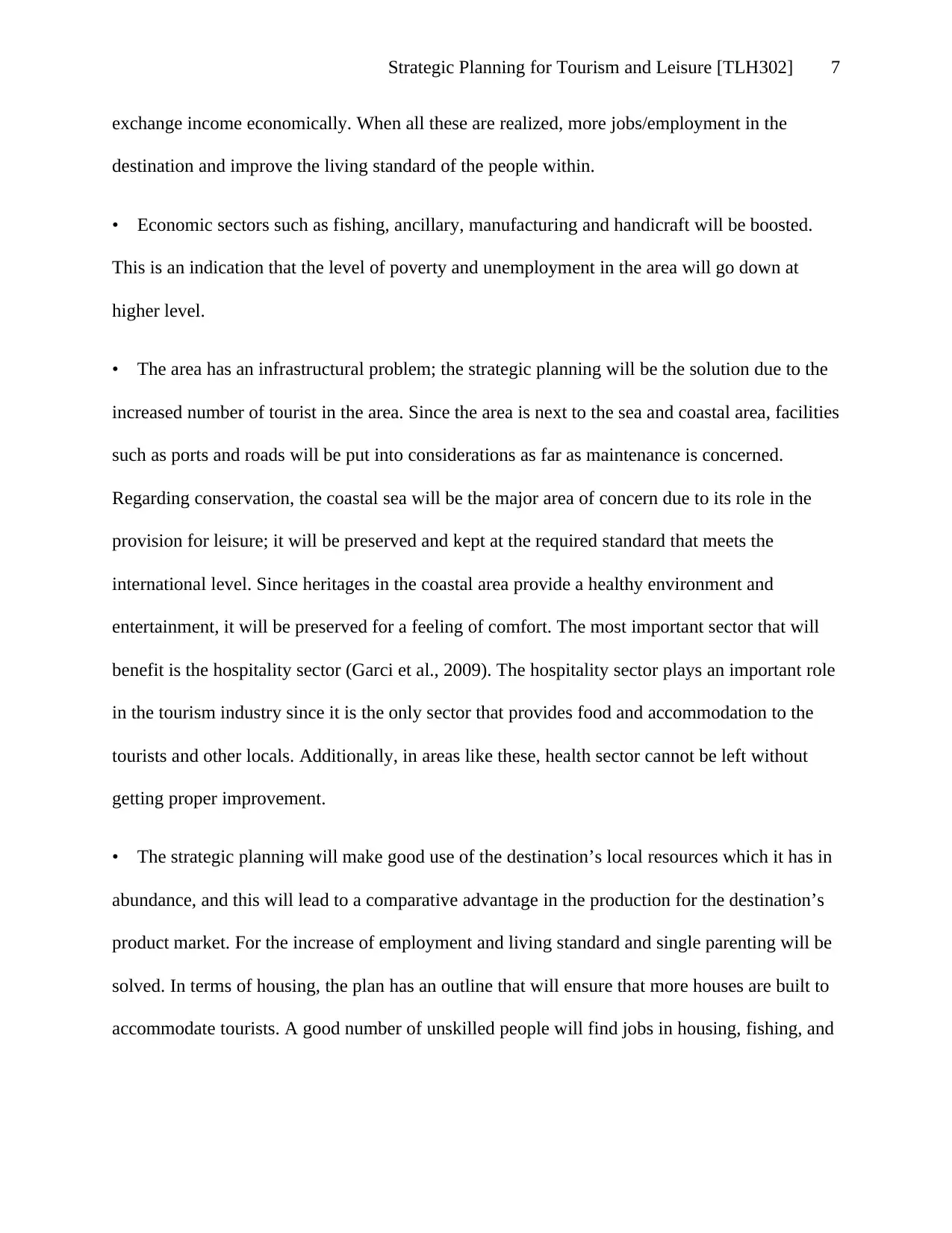
Strategic Planning for Tourism and Leisure [TLH302] 7
exchange income economically. When all these are realized, more jobs/employment in the
destination and improve the living standard of the people within.
• Economic sectors such as fishing, ancillary, manufacturing and handicraft will be boosted.
This is an indication that the level of poverty and unemployment in the area will go down at
higher level.
• The area has an infrastructural problem; the strategic planning will be the solution due to the
increased number of tourist in the area. Since the area is next to the sea and coastal area, facilities
such as ports and roads will be put into considerations as far as maintenance is concerned.
Regarding conservation, the coastal sea will be the major area of concern due to its role in the
provision for leisure; it will be preserved and kept at the required standard that meets the
international level. Since heritages in the coastal area provide a healthy environment and
entertainment, it will be preserved for a feeling of comfort. The most important sector that will
benefit is the hospitality sector (Garci et al., 2009). The hospitality sector plays an important role
in the tourism industry since it is the only sector that provides food and accommodation to the
tourists and other locals. Additionally, in areas like these, health sector cannot be left without
getting proper improvement.
• The strategic planning will make good use of the destination’s local resources which it has in
abundance, and this will lead to a comparative advantage in the production for the destination’s
product market. For the increase of employment and living standard and single parenting will be
solved. In terms of housing, the plan has an outline that will ensure that more houses are built to
accommodate tourists. A good number of unskilled people will find jobs in housing, fishing, and
exchange income economically. When all these are realized, more jobs/employment in the
destination and improve the living standard of the people within.
• Economic sectors such as fishing, ancillary, manufacturing and handicraft will be boosted.
This is an indication that the level of poverty and unemployment in the area will go down at
higher level.
• The area has an infrastructural problem; the strategic planning will be the solution due to the
increased number of tourist in the area. Since the area is next to the sea and coastal area, facilities
such as ports and roads will be put into considerations as far as maintenance is concerned.
Regarding conservation, the coastal sea will be the major area of concern due to its role in the
provision for leisure; it will be preserved and kept at the required standard that meets the
international level. Since heritages in the coastal area provide a healthy environment and
entertainment, it will be preserved for a feeling of comfort. The most important sector that will
benefit is the hospitality sector (Garci et al., 2009). The hospitality sector plays an important role
in the tourism industry since it is the only sector that provides food and accommodation to the
tourists and other locals. Additionally, in areas like these, health sector cannot be left without
getting proper improvement.
• The strategic planning will make good use of the destination’s local resources which it has in
abundance, and this will lead to a comparative advantage in the production for the destination’s
product market. For the increase of employment and living standard and single parenting will be
solved. In terms of housing, the plan has an outline that will ensure that more houses are built to
accommodate tourists. A good number of unskilled people will find jobs in housing, fishing, and
Paraphrase This Document
Need a fresh take? Get an instant paraphrase of this document with our AI Paraphraser
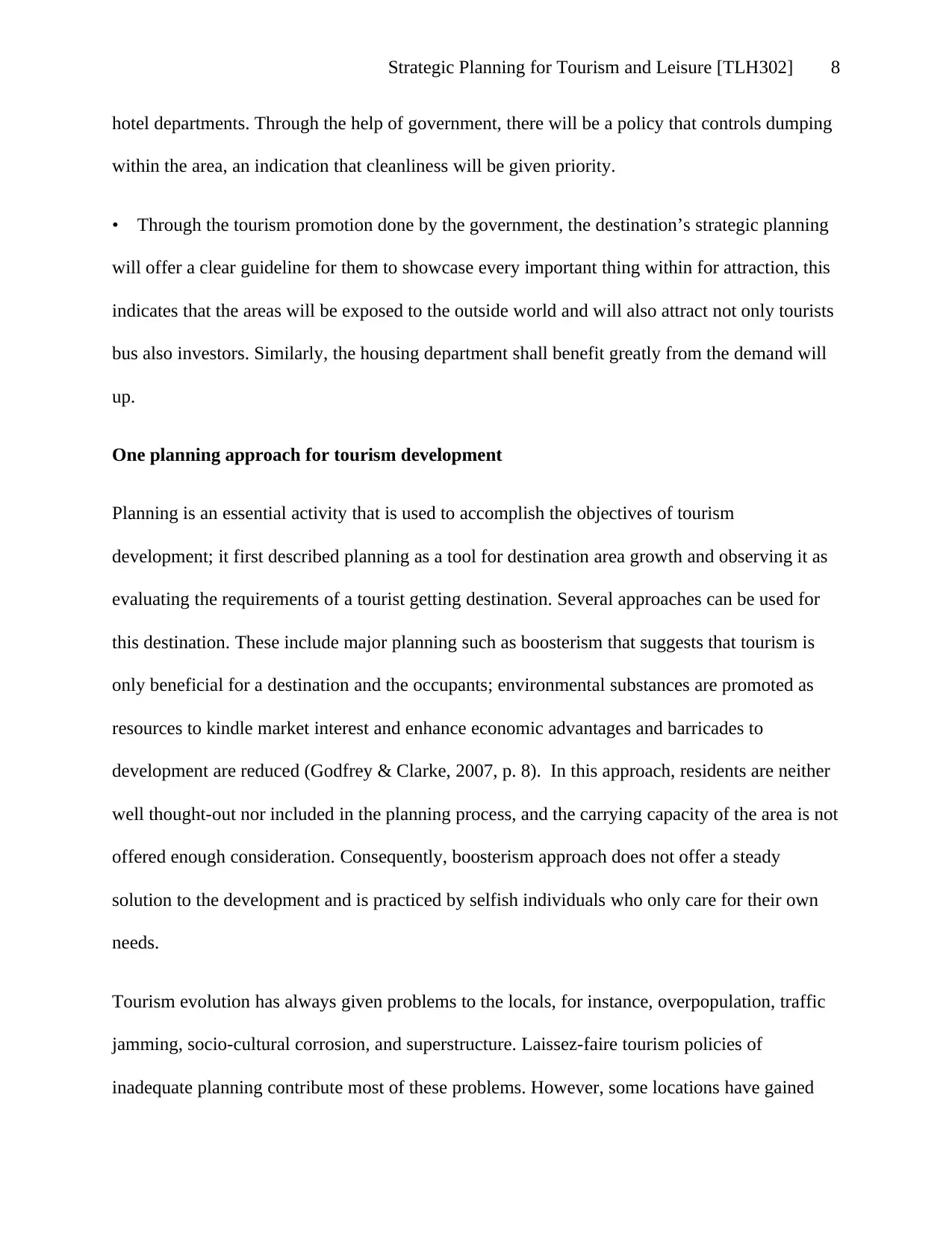
Strategic Planning for Tourism and Leisure [TLH302] 8
hotel departments. Through the help of government, there will be a policy that controls dumping
within the area, an indication that cleanliness will be given priority.
• Through the tourism promotion done by the government, the destination’s strategic planning
will offer a clear guideline for them to showcase every important thing within for attraction, this
indicates that the areas will be exposed to the outside world and will also attract not only tourists
bus also investors. Similarly, the housing department shall benefit greatly from the demand will
up.
One planning approach for tourism development
Planning is an essential activity that is used to accomplish the objectives of tourism
development; it first described planning as a tool for destination area growth and observing it as
evaluating the requirements of a tourist getting destination. Several approaches can be used for
this destination. These include major planning such as boosterism that suggests that tourism is
only beneficial for a destination and the occupants; environmental substances are promoted as
resources to kindle market interest and enhance economic advantages and barricades to
development are reduced (Godfrey & Clarke, 2007, p. 8). In this approach, residents are neither
well thought-out nor included in the planning process, and the carrying capacity of the area is not
offered enough consideration. Consequently, boosterism approach does not offer a steady
solution to the development and is practiced by selfish individuals who only care for their own
needs.
Tourism evolution has always given problems to the locals, for instance, overpopulation, traffic
jamming, socio-cultural corrosion, and superstructure. Laissez-faire tourism policies of
inadequate planning contribute most of these problems. However, some locations have gained
hotel departments. Through the help of government, there will be a policy that controls dumping
within the area, an indication that cleanliness will be given priority.
• Through the tourism promotion done by the government, the destination’s strategic planning
will offer a clear guideline for them to showcase every important thing within for attraction, this
indicates that the areas will be exposed to the outside world and will also attract not only tourists
bus also investors. Similarly, the housing department shall benefit greatly from the demand will
up.
One planning approach for tourism development
Planning is an essential activity that is used to accomplish the objectives of tourism
development; it first described planning as a tool for destination area growth and observing it as
evaluating the requirements of a tourist getting destination. Several approaches can be used for
this destination. These include major planning such as boosterism that suggests that tourism is
only beneficial for a destination and the occupants; environmental substances are promoted as
resources to kindle market interest and enhance economic advantages and barricades to
development are reduced (Godfrey & Clarke, 2007, p. 8). In this approach, residents are neither
well thought-out nor included in the planning process, and the carrying capacity of the area is not
offered enough consideration. Consequently, boosterism approach does not offer a steady
solution to the development and is practiced by selfish individuals who only care for their own
needs.
Tourism evolution has always given problems to the locals, for instance, overpopulation, traffic
jamming, socio-cultural corrosion, and superstructure. Laissez-faire tourism policies of
inadequate planning contribute most of these problems. However, some locations have gained
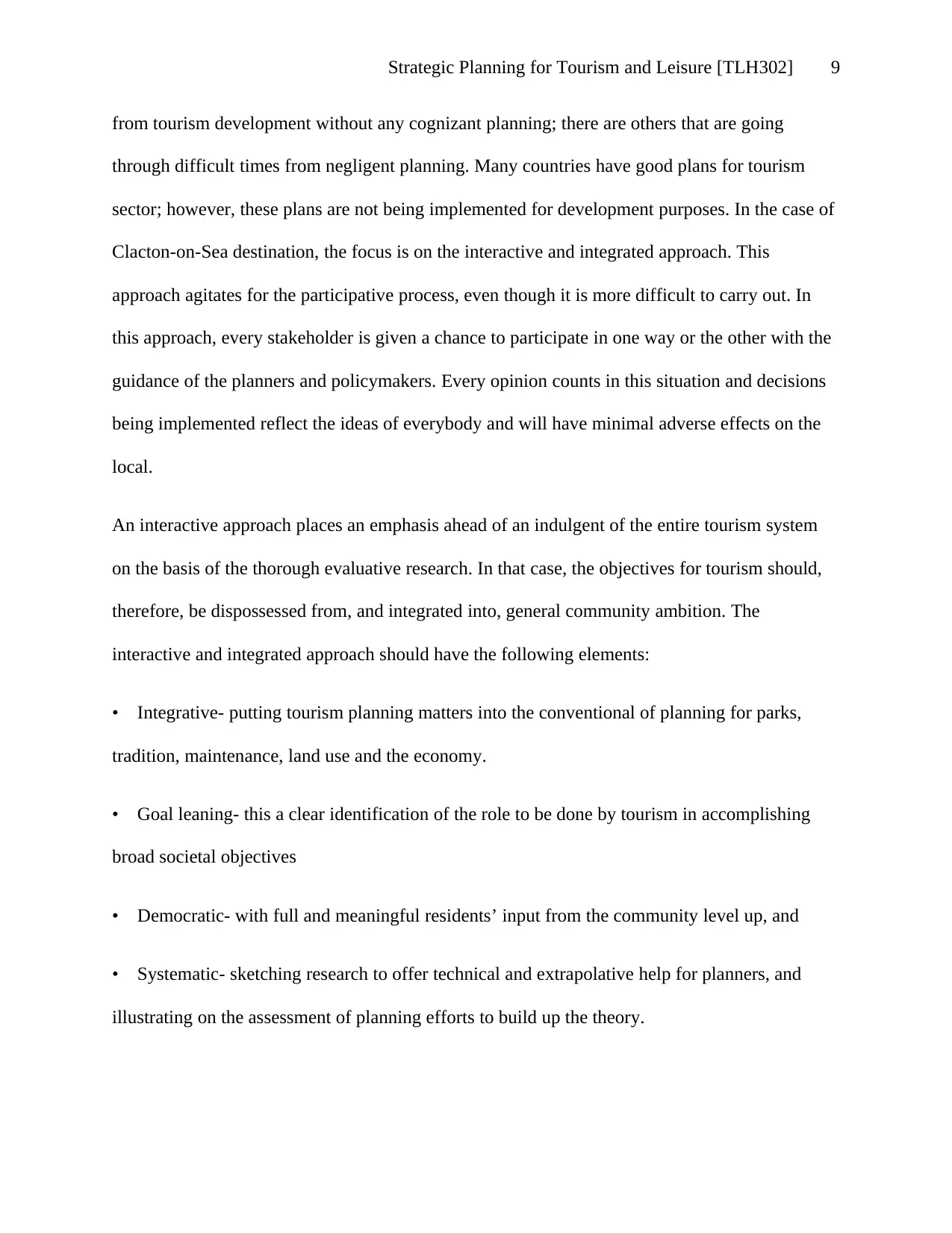
Strategic Planning for Tourism and Leisure [TLH302] 9
from tourism development without any cognizant planning; there are others that are going
through difficult times from negligent planning. Many countries have good plans for tourism
sector; however, these plans are not being implemented for development purposes. In the case of
Clacton-on-Sea destination, the focus is on the interactive and integrated approach. This
approach agitates for the participative process, even though it is more difficult to carry out. In
this approach, every stakeholder is given a chance to participate in one way or the other with the
guidance of the planners and policymakers. Every opinion counts in this situation and decisions
being implemented reflect the ideas of everybody and will have minimal adverse effects on the
local.
An interactive approach places an emphasis ahead of an indulgent of the entire tourism system
on the basis of the thorough evaluative research. In that case, the objectives for tourism should,
therefore, be dispossessed from, and integrated into, general community ambition. The
interactive and integrated approach should have the following elements:
• Integrative- putting tourism planning matters into the conventional of planning for parks,
tradition, maintenance, land use and the economy.
• Goal leaning- this a clear identification of the role to be done by tourism in accomplishing
broad societal objectives
• Democratic- with full and meaningful residents’ input from the community level up, and
• Systematic- sketching research to offer technical and extrapolative help for planners, and
illustrating on the assessment of planning efforts to build up the theory.
from tourism development without any cognizant planning; there are others that are going
through difficult times from negligent planning. Many countries have good plans for tourism
sector; however, these plans are not being implemented for development purposes. In the case of
Clacton-on-Sea destination, the focus is on the interactive and integrated approach. This
approach agitates for the participative process, even though it is more difficult to carry out. In
this approach, every stakeholder is given a chance to participate in one way or the other with the
guidance of the planners and policymakers. Every opinion counts in this situation and decisions
being implemented reflect the ideas of everybody and will have minimal adverse effects on the
local.
An interactive approach places an emphasis ahead of an indulgent of the entire tourism system
on the basis of the thorough evaluative research. In that case, the objectives for tourism should,
therefore, be dispossessed from, and integrated into, general community ambition. The
interactive and integrated approach should have the following elements:
• Integrative- putting tourism planning matters into the conventional of planning for parks,
tradition, maintenance, land use and the economy.
• Goal leaning- this a clear identification of the role to be done by tourism in accomplishing
broad societal objectives
• Democratic- with full and meaningful residents’ input from the community level up, and
• Systematic- sketching research to offer technical and extrapolative help for planners, and
illustrating on the assessment of planning efforts to build up the theory.
⊘ This is a preview!⊘
Do you want full access?
Subscribe today to unlock all pages.

Trusted by 1+ million students worldwide
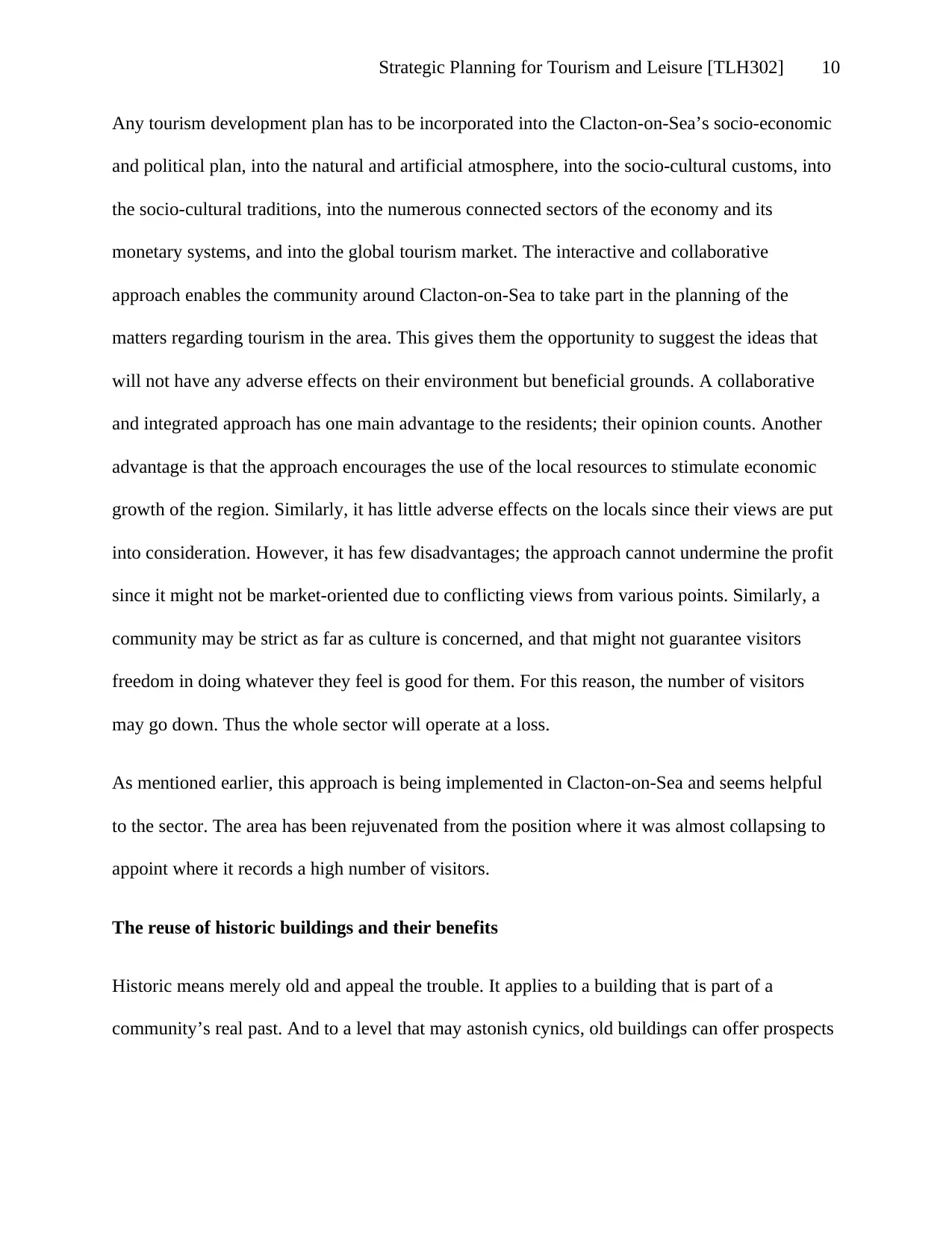
Strategic Planning for Tourism and Leisure [TLH302] 10
Any tourism development plan has to be incorporated into the Clacton-on-Sea’s socio-economic
and political plan, into the natural and artificial atmosphere, into the socio-cultural customs, into
the socio-cultural traditions, into the numerous connected sectors of the economy and its
monetary systems, and into the global tourism market. The interactive and collaborative
approach enables the community around Clacton-on-Sea to take part in the planning of the
matters regarding tourism in the area. This gives them the opportunity to suggest the ideas that
will not have any adverse effects on their environment but beneficial grounds. A collaborative
and integrated approach has one main advantage to the residents; their opinion counts. Another
advantage is that the approach encourages the use of the local resources to stimulate economic
growth of the region. Similarly, it has little adverse effects on the locals since their views are put
into consideration. However, it has few disadvantages; the approach cannot undermine the profit
since it might not be market-oriented due to conflicting views from various points. Similarly, a
community may be strict as far as culture is concerned, and that might not guarantee visitors
freedom in doing whatever they feel is good for them. For this reason, the number of visitors
may go down. Thus the whole sector will operate at a loss.
As mentioned earlier, this approach is being implemented in Clacton-on-Sea and seems helpful
to the sector. The area has been rejuvenated from the position where it was almost collapsing to
appoint where it records a high number of visitors.
The reuse of historic buildings and their benefits
Historic means merely old and appeal the trouble. It applies to a building that is part of a
community’s real past. And to a level that may astonish cynics, old buildings can offer prospects
Any tourism development plan has to be incorporated into the Clacton-on-Sea’s socio-economic
and political plan, into the natural and artificial atmosphere, into the socio-cultural customs, into
the socio-cultural traditions, into the numerous connected sectors of the economy and its
monetary systems, and into the global tourism market. The interactive and collaborative
approach enables the community around Clacton-on-Sea to take part in the planning of the
matters regarding tourism in the area. This gives them the opportunity to suggest the ideas that
will not have any adverse effects on their environment but beneficial grounds. A collaborative
and integrated approach has one main advantage to the residents; their opinion counts. Another
advantage is that the approach encourages the use of the local resources to stimulate economic
growth of the region. Similarly, it has little adverse effects on the locals since their views are put
into consideration. However, it has few disadvantages; the approach cannot undermine the profit
since it might not be market-oriented due to conflicting views from various points. Similarly, a
community may be strict as far as culture is concerned, and that might not guarantee visitors
freedom in doing whatever they feel is good for them. For this reason, the number of visitors
may go down. Thus the whole sector will operate at a loss.
As mentioned earlier, this approach is being implemented in Clacton-on-Sea and seems helpful
to the sector. The area has been rejuvenated from the position where it was almost collapsing to
appoint where it records a high number of visitors.
The reuse of historic buildings and their benefits
Historic means merely old and appeal the trouble. It applies to a building that is part of a
community’s real past. And to a level that may astonish cynics, old buildings can offer prospects
Paraphrase This Document
Need a fresh take? Get an instant paraphrase of this document with our AI Paraphraser
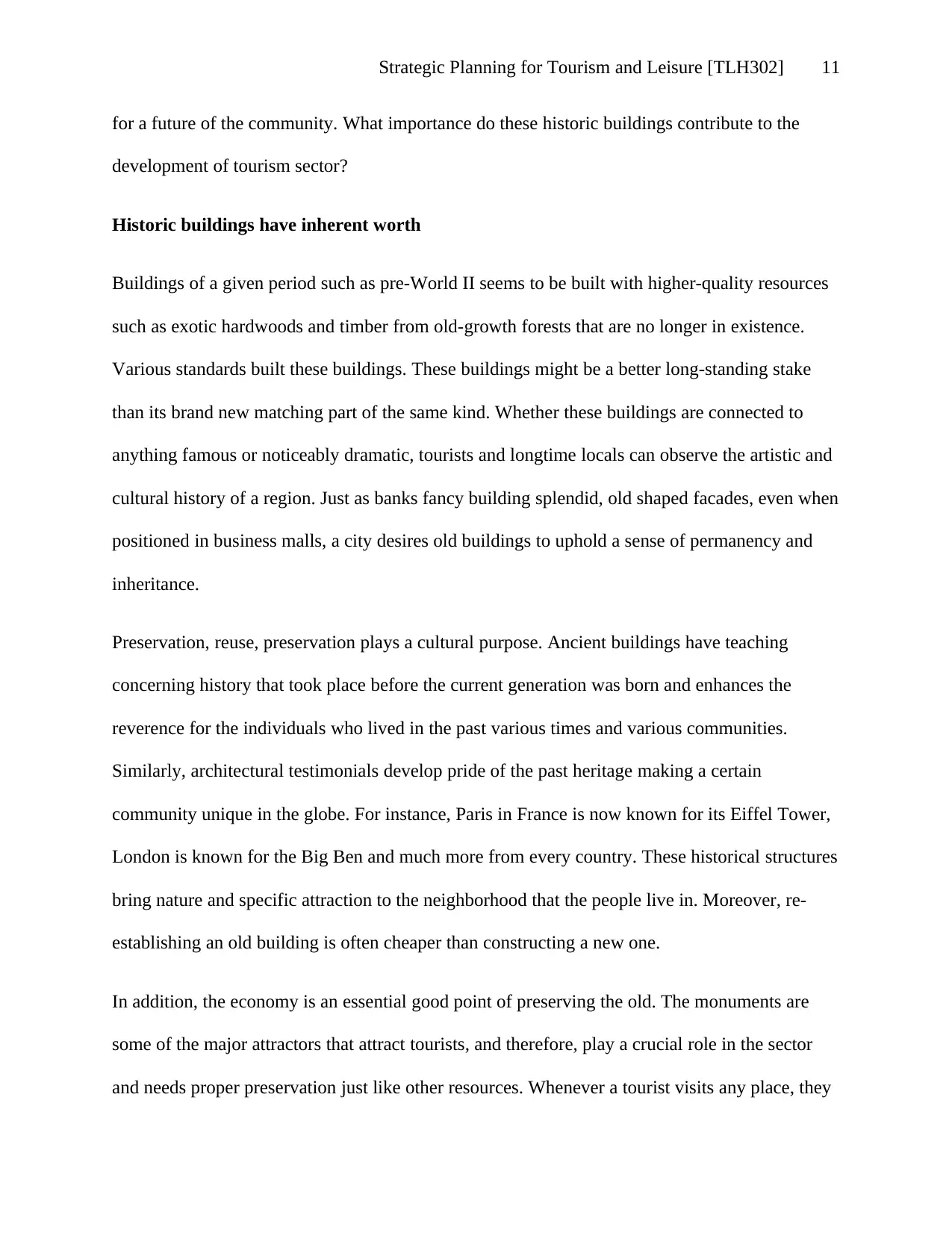
Strategic Planning for Tourism and Leisure [TLH302] 11
for a future of the community. What importance do these historic buildings contribute to the
development of tourism sector?
Historic buildings have inherent worth
Buildings of a given period such as pre-World II seems to be built with higher-quality resources
such as exotic hardwoods and timber from old-growth forests that are no longer in existence.
Various standards built these buildings. These buildings might be a better long-standing stake
than its brand new matching part of the same kind. Whether these buildings are connected to
anything famous or noticeably dramatic, tourists and longtime locals can observe the artistic and
cultural history of a region. Just as banks fancy building splendid, old shaped facades, even when
positioned in business malls, a city desires old buildings to uphold a sense of permanency and
inheritance.
Preservation, reuse, preservation plays a cultural purpose. Ancient buildings have teaching
concerning history that took place before the current generation was born and enhances the
reverence for the individuals who lived in the past various times and various communities.
Similarly, architectural testimonials develop pride of the past heritage making a certain
community unique in the globe. For instance, Paris in France is now known for its Eiffel Tower,
London is known for the Big Ben and much more from every country. These historical structures
bring nature and specific attraction to the neighborhood that the people live in. Moreover, re-
establishing an old building is often cheaper than constructing a new one.
In addition, the economy is an essential good point of preserving the old. The monuments are
some of the major attractors that attract tourists, and therefore, play a crucial role in the sector
and needs proper preservation just like other resources. Whenever a tourist visits any place, they
for a future of the community. What importance do these historic buildings contribute to the
development of tourism sector?
Historic buildings have inherent worth
Buildings of a given period such as pre-World II seems to be built with higher-quality resources
such as exotic hardwoods and timber from old-growth forests that are no longer in existence.
Various standards built these buildings. These buildings might be a better long-standing stake
than its brand new matching part of the same kind. Whether these buildings are connected to
anything famous or noticeably dramatic, tourists and longtime locals can observe the artistic and
cultural history of a region. Just as banks fancy building splendid, old shaped facades, even when
positioned in business malls, a city desires old buildings to uphold a sense of permanency and
inheritance.
Preservation, reuse, preservation plays a cultural purpose. Ancient buildings have teaching
concerning history that took place before the current generation was born and enhances the
reverence for the individuals who lived in the past various times and various communities.
Similarly, architectural testimonials develop pride of the past heritage making a certain
community unique in the globe. For instance, Paris in France is now known for its Eiffel Tower,
London is known for the Big Ben and much more from every country. These historical structures
bring nature and specific attraction to the neighborhood that the people live in. Moreover, re-
establishing an old building is often cheaper than constructing a new one.
In addition, the economy is an essential good point of preserving the old. The monuments are
some of the major attractors that attract tourists, and therefore, play a crucial role in the sector
and needs proper preservation just like other resources. Whenever a tourist visits any place, they
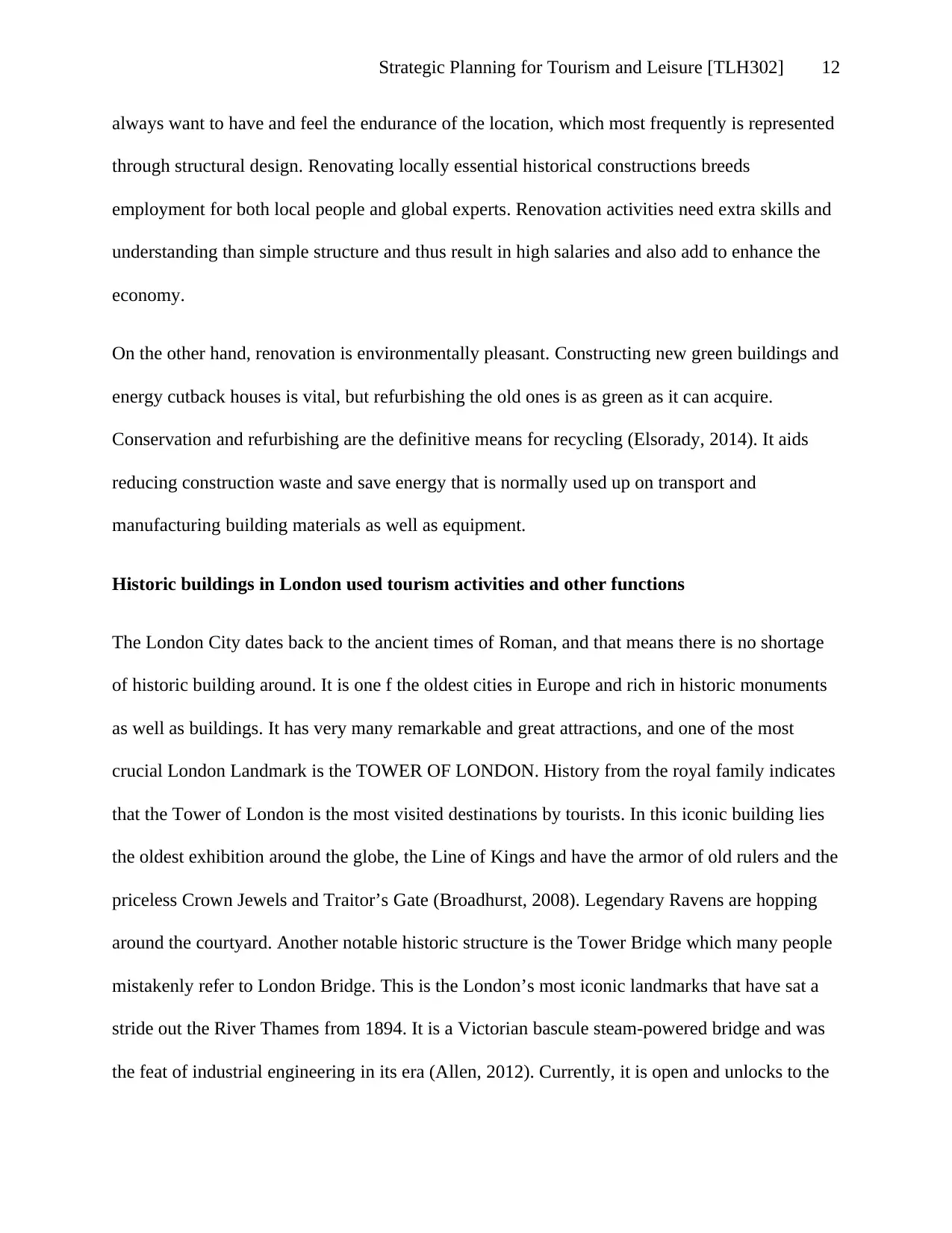
Strategic Planning for Tourism and Leisure [TLH302] 12
always want to have and feel the endurance of the location, which most frequently is represented
through structural design. Renovating locally essential historical constructions breeds
employment for both local people and global experts. Renovation activities need extra skills and
understanding than simple structure and thus result in high salaries and also add to enhance the
economy.
On the other hand, renovation is environmentally pleasant. Constructing new green buildings and
energy cutback houses is vital, but refurbishing the old ones is as green as it can acquire.
Conservation and refurbishing are the definitive means for recycling (Elsorady, 2014). It aids
reducing construction waste and save energy that is normally used up on transport and
manufacturing building materials as well as equipment.
Historic buildings in London used tourism activities and other functions
The London City dates back to the ancient times of Roman, and that means there is no shortage
of historic building around. It is one f the oldest cities in Europe and rich in historic monuments
as well as buildings. It has very many remarkable and great attractions, and one of the most
crucial London Landmark is the TOWER OF LONDON. History from the royal family indicates
that the Tower of London is the most visited destinations by tourists. In this iconic building lies
the oldest exhibition around the globe, the Line of Kings and have the armor of old rulers and the
priceless Crown Jewels and Traitor’s Gate (Broadhurst, 2008). Legendary Ravens are hopping
around the courtyard. Another notable historic structure is the Tower Bridge which many people
mistakenly refer to London Bridge. This is the London’s most iconic landmarks that have sat a
stride out the River Thames from 1894. It is a Victorian bascule steam-powered bridge and was
the feat of industrial engineering in its era (Allen, 2012). Currently, it is open and unlocks to the
always want to have and feel the endurance of the location, which most frequently is represented
through structural design. Renovating locally essential historical constructions breeds
employment for both local people and global experts. Renovation activities need extra skills and
understanding than simple structure and thus result in high salaries and also add to enhance the
economy.
On the other hand, renovation is environmentally pleasant. Constructing new green buildings and
energy cutback houses is vital, but refurbishing the old ones is as green as it can acquire.
Conservation and refurbishing are the definitive means for recycling (Elsorady, 2014). It aids
reducing construction waste and save energy that is normally used up on transport and
manufacturing building materials as well as equipment.
Historic buildings in London used tourism activities and other functions
The London City dates back to the ancient times of Roman, and that means there is no shortage
of historic building around. It is one f the oldest cities in Europe and rich in historic monuments
as well as buildings. It has very many remarkable and great attractions, and one of the most
crucial London Landmark is the TOWER OF LONDON. History from the royal family indicates
that the Tower of London is the most visited destinations by tourists. In this iconic building lies
the oldest exhibition around the globe, the Line of Kings and have the armor of old rulers and the
priceless Crown Jewels and Traitor’s Gate (Broadhurst, 2008). Legendary Ravens are hopping
around the courtyard. Another notable historic structure is the Tower Bridge which many people
mistakenly refer to London Bridge. This is the London’s most iconic landmarks that have sat a
stride out the River Thames from 1894. It is a Victorian bascule steam-powered bridge and was
the feat of industrial engineering in its era (Allen, 2012). Currently, it is open and unlocks to the
⊘ This is a preview!⊘
Do you want full access?
Subscribe today to unlock all pages.

Trusted by 1+ million students worldwide
1 out of 19
Related Documents
Your All-in-One AI-Powered Toolkit for Academic Success.
+13062052269
info@desklib.com
Available 24*7 on WhatsApp / Email
![[object Object]](/_next/static/media/star-bottom.7253800d.svg)
Unlock your academic potential
Copyright © 2020–2025 A2Z Services. All Rights Reserved. Developed and managed by ZUCOL.





